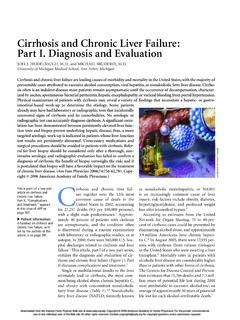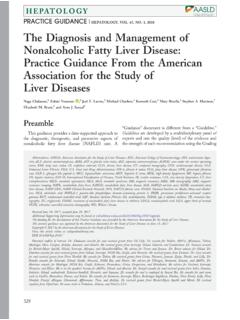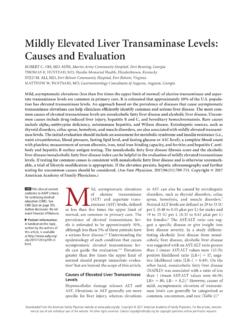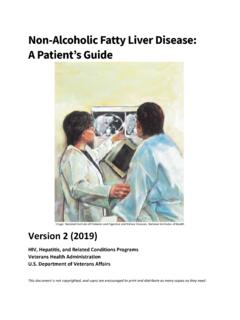Transcription of Nutrition in Non-Alcoholic Fatty Liver Disease
1 This is a consensus document from Dietitian/ Nutritionists from the Nutrition Education Materials Online, "NEMO", team Disclaimer: Reviewed: January 2021 Copyright: Due for review: January 2023 1 My Nutrition My Nutrition Metabolic Associated Fatty Liver Disease (MAFLD) This resource is for people with metabolic associated Fatty Liver Disease (MAFLD). It provides Nutrition and lifestyle information to help you manage your condition. What is MAFLD? MAFLD is a condition where excess fat builds up in the Liver . Risk factors include: Being obese or overweight Having diabetes Having high blood cholesterol and triglyceride (a type of blood fat) levels Are MAFLD and nafld the same?
2 In the past, Fatty Liver was called Non-Alcoholic Fatty Liver Disease , also known as nafld . Recently however, a decision was made between clinicians and patients to change the name to MAFLD to better describe the condition. What are the effects of MAFLD? MAFLD does not always cause harm to the Liver , but it can: Increase your risk of diabetes, heart attack or stroke Progress to more severe Liver Disease . The fat around the Liver can cause inflammation of the Liver . Ongoing inflammation may cause cirrhosis (irreversible scarring of the Liver ), which can lead to Liver failure. What should you do if you have MAFLD? Avoid smoking and alcohol Participate in regular exercise Eat a healthy balanced diet Have good blood sugar control (if you have diabetes) Treat high blood pressure and high cholesterol My Nutrition This is a consensus document from Dietitian/ Nutritionists from the Nutrition Education Materials Online, "NEMO", team.
3 Disclaimer: Reviewed: January 2021 Copyright: Due for review: January 2023 My Nutrition My Nutrition To reduce the risk of developing MALFD you can: 1. Eat a healthy diet 2. Reach a healthy weight 3. Increase exercise 1. Eat a healthy diet Make changes slowly so you can continue them long-term, maintain weight loss and keep your Liver healthy. Base your meals on whole foods from the Mediterranean diet 1. Vegetables add as many vegetables as you can to your meals and snacks. 2. Fruit eat at least two pieces of fruit per day. 3. Add olive oil to your food (up to 3 tablespoons per day). 4. Include fish at least twice weekly. 5. Choose low fat meat or meat alternatives like chicken, eggs, and legumes ( chickpeas, kidney beans, and nuts).
4 6. Reduce red meat to once per week or on special occasions. 7. Choose grainy breads and cereals, rice and pasta. 8. Choose low fat dairy ( milk, yoghurt, cheese). Eating foods from these main food groups will help keep you full and reduce the need to snack on high fat or high sugar foods. Refer to the NEMO Mediterranean diet sheet for more information ( ). This is a consensus document from Dietitian/ Nutritionists from the Nutrition Education Materials Online, "NEMO", team. Disclaimer: Reviewed: January 2021 Copyright: Due for review: January 2023 My Nutrition My Nutrition Image reproduced with permission from Oldways - NOTE: When you have Liver Disease , it is best to avoid alcohol.
5 But this should be discussed with your GP or Liver doctor. Switch to healthier drinks Choose water as your main drink. Replace sugary drinks like soft drinks, cordials, sports drinks and juices with no added sugar or diet alternatives. Talk to your doctor to check if you should avoid alcohol. Reduce your portion sizes Use smaller plates and bowls to help reduce calories for weight loss. This is a consensus document from Dietitian/ Nutritionists from the Nutrition Education Materials Online, "NEMO", team. Disclaimer: Reviewed: January 2021 Copyright: Due for review: January 2023 My Nutrition My Nutrition Fill up on high fibre foods Eat high fibre foods such as grainy breads and cereals, vegetables, legumes and fruit.
6 By choosing these foods, you may find you can eat more food but with less calories. Examples of higher fibre choices with more food and less calories include: 2 pieces of fruit instead of 1 glass of fruit drink 1 medium jacket potato instead of bucket of hot chips 2 cups air -popped popcorn instead of small packet chips Plan your meals This can help you avoid making impulse decisions or reduce the temptation to grab takeaway, which may lead to overeating. Build a balanced plate Include a large serve of vegetables (1/2 of the plate), a palm sized protein portion (1/4 of the plate), and a small serve of carbohydrate (1/4 of the plate). Image reproduced with permission from Healthy Food Guide Magazine This is a consensus document from Dietitian/ Nutritionists from the Nutrition Education Materials Online, "NEMO", team.
7 Disclaimer: Reviewed: January 2021 Copyright: Due for review: January 2023 My Nutrition My Nutrition Not all fats are equal All fats are high in energy, however there are several different types of fat. Unsaturated fats are a healthy type of fat. Include these fats in your diet to reduce your risk of heart Disease . They include: Monounsaturated fats found in extra virgin olive oil, avocados, olives and nuts (almonds and cashews). Polyunsaturated fats found in sunflower seeds and oil, canola oil, soybeans and soymilk, nuts (walnuts, hazel and Brazil), seeds (chia, flaxseed and sunflower), oily fish and seafood (salmon, sardines, tuna and mussels).
8 Saturated fats are not so good for our health and should be limited in your diet. Saturated fats found in animal fats (butter, lard, ghee), coconut oil, full fat dairy, deep fried foods and pastries, fat on meat, cream, sour cream and deli meats. Limit added sugars Added sugars can increase the calories in your diet and are low in nutrients. Ideas to reduce added sugar include: Use less/no sugar in your tea/coffee Try fruit instead of sugar on cereal Use sugar free spreads instead of jam and honey. Options include vegemite, peanut butter (no added sugar) or spreads sweetened with artificial sweeteners or stevia. Replace fruit juice with fresh fruit Eat tinned fruit in water/natural juice instead of syrup Use unsweetened yoghurt (natural/Greek) instead of sweetened yoghurt Eat less biscuits and cakes 2.
9 Reach a healthy weight If you are overweight, losing 5-10% of your body weight can: Decrease fat in the Liver Improve blood sugar control Improve blood pressure This is a consensus document from Dietitian/ Nutritionists from the Nutrition Education Materials Online, "NEMO", team. Disclaimer: Reviewed: January 2021 Copyright: Due for review: January 2023 My Nutrition My Nutrition Aim for a loss of per week. Your current weight: _____ Your goal weight: _____ Your waist circumference: _____ Goal waist circumferences: Females: Initially: less than 88cm Long term: less than 80cm Males: Initially: less than 102cm Long term: less than 94cm 3.
10 Increase exercise Increasing activity can help you reach a healthy weight. It can also decrease your risk of developing diabetes and help control your blood sugar. Try to do at least 150 minutes of moderate intensity exercise per week (30 minutes of activity 5 times per week), increasing to 30-45 minutes daily. Examples of moderate intensity exercise include brisk walking, dancing and gardening. Talk to your doctor before starting any physical activity if you have existing medical conditions, as you may benefit from a referral to an exercise physiologist. It s also important to keep in touch with your diabetes educator and manage your blood sugar well if you have diabetes. Ideas to increase activity Aim to be active every day in as many ways as you can ( join a dance class or walking group).

















